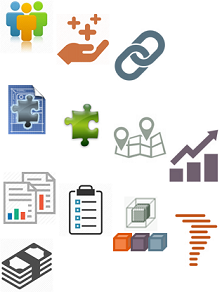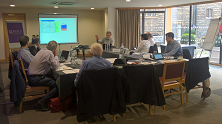 Our most recent customer event was held on 27–28 September 2017 at King’s College, Cambridge. The original programme advertised in April 2017 evolved to accommodate an exploration of three growth models for a start-up business, from unconstrained to measured to driven, as outlined in our July newsletter.
Our most recent customer event was held on 27–28 September 2017 at King’s College, Cambridge. The original programme advertised in April 2017 evolved to accommodate an exploration of three growth models for a start-up business, from unconstrained to measured to driven, as outlined in our July newsletter.
Four sessions of the event were given over to the associated modelling track, which is described in some detail in this separate article. The rest of the event covered the forthcoming STEM major version 8.0, Implied Logic’s own revised business model, and two guest presentations.
Note: the full proceedings of the event are available as a free download from the RHS of this page.
| Wednesday 27 September 2017 |
Thursday 28 September 2017 |
|
A simpler way of working with STEM 8.0: ever closer to a ‘whiteboard-like experience’ on-screen |
The essential reality check: comparing a fixed resource base with a more agile, driver-based approach |
|
Modelling reset: setting the scene for a detailed, generic business case to build from the ground up |
The new business-model canvas for Implied Logic: making STEM more accessible and affordable |
|
Guest presentations
|
When customers shape your business: exploring growth scenarios to maximise a market opportunity |
|
A driverless case: here are the revenues, here are the costs; does the enterprise make money? |
Future development clinic: interactive discussion on platform, company and community evolution |
| GALA DINNER at King’s College |
Informal meal at Robin’s favourite pizza restaurant |
Figure 1: Final programme for the STEM User Group Meeting 2017
 The event kicked off with a triumphant showcase of What’s new in STEM 8.0. A new and compelling set of icons for the main element types provoked much discussion, but also broad approval and acceptance by the time a latest development build featuring the new icons had been used throughout the modelling track. (The earlier sketches presented in 2015 never made it further than Powerpoint!)
The event kicked off with a triumphant showcase of What’s new in STEM 8.0. A new and compelling set of icons for the main element types provoked much discussion, but also broad approval and acceptance by the time a latest development build featuring the new icons had been used throughout the modelling track. (The earlier sketches presented in 2015 never made it further than Powerpoint!)
There was also much debate about which user-interface styles would be most successful for the newly-implemented and universally-welcome support for inserting, deleting and moving user data (and other arrays such as scenario and template parameters and variant data).
The new visual editing enhancements, such as the context toolbar and direct connect between icons, were very evident in the modelling sessions, but easily the most visible improvement was the integration of results charts in the Editor. Not only did this make the results more immediate, but it made them more relevant too as you could check the numbers right next to the related model structure and connections. Indeed, some of the most relevant charts were summoned directly by selecting Trace Results from the context menu for a connection between two elements.

Figure 2: Tracing the calculation flow between two connected elements
This was a particular boon for the workshop audience as it meant that we could stick to a single screen without constantly switching windows as was the accepted norm in the past. Adding new resources to an existing chart with drag-and-drop was the icing on the cake which simply underscored the power of these visual tools to keep an audience connected and engaged.
The guest presentations slot, which kicked-off with a vision for using STEM to model budgets for the NHS in the UK and other large-scale public services worldwide, featured two very different talks:

-
Manfred Illenberger presented a fascinating application of STEM for modelling personal finances and savings for retirement, one of the few situations where a declining NPV is on the cards!
-
Michael Eaton delivered an update on the IT and network security environment, and why businesses should be evaluating carefully the cost and benefit implications of varying responses to increasing and emerging security threats.
The General Data Protection Regulation (GDPR), which will be enforceable within the EU from 25 May 2018, is intended to spur responsible custodians of personal data into action, but it also threatens a heavy stick for those that fail to do so. This was one of the inspirations for the concurrent and separate article on The imperative to evaluate strategic alternatives.
 The session on the new business-model canvas for Implied Logic provided a candid insight into the challenges of altering an existing business model. Implied Logic has already wrought an impressive transformation of its readiness to serve other markets, but still has another mountain to climb to actually connect with them effectively!
The session on the new business-model canvas for Implied Logic provided a candid insight into the challenges of altering an existing business model. Implied Logic has already wrought an impressive transformation of its readiness to serve other markets, but still has another mountain to climb to actually connect with them effectively!
 The closing and ever popular Future development clinic session focused on the ‘also rans’ for STEM 8.0 and invited the audience to influence what else we might slip into the final package. The release date is not yet fixed, but the sincere aim is for ‘before Christmas’. Watch out for an update in our January newsletter!
The closing and ever popular Future development clinic session focused on the ‘also rans’ for STEM 8.0 and invited the audience to influence what else we might slip into the final package. The release date is not yet fixed, but the sincere aim is for ‘before Christmas’. Watch out for an update in our January newsletter!
You can read about the ideas discussed in this session, as well as all the topics from the rest of the event, in the full proceedings which are available now as a free download from the RHS of this page to registered website visitors. (You will just need to log-in if you are already registered.)